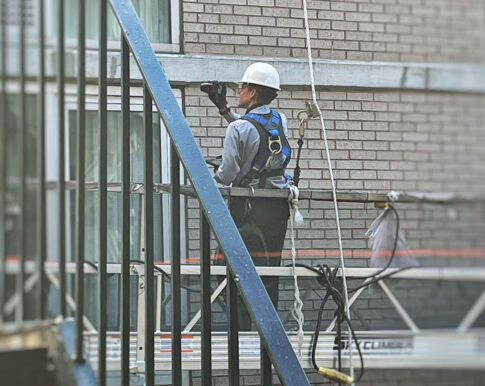
Here’s When You Must File in NYC’s Cycle 10 (2025–2029)
If your building is six stories or taller and was newly constructed, it may now be required to have its facade inspected and a Facade Inspection Safety Program (FISP) report filed for the first time in Cycle 10.
Under DOB rules, a building becomes subject to FISP when five years have passed since the date of its initial Temporary Certificate of Occupancy (TCO). If no TCO was ever issued, the date of the Final Certificate of Occupancy (CO) is used instead.
Whether your building needs to file in the current Cycle 10 or wait until Cycle 11 depends on two factors:
- When your initial TCO or final CO was issued
- Which sub-cycle your building falls under, based on the last digit of your block number
We break it down below so you can easily determine if you're required to file this cycle.
FISP Cycle 10 Sub-Cycles and Cutoff Dates
Sub-Cycle 10A
Block number ends in:4, 5, 6, or 9
Filing window:February 21, 2025 – February 21, 2027
Must file if the initial TCO was issued on or before: February 21, 2020 (or if no initial TCO was issued, the final CO was issued on or before this date)
Sub-Cycle 10B
Block number ends in:0, 7, or 8
Filing window:February 21, 2026 – February 21, 2028
Must file if the initial TCO was issued on or before: February 21, 2021 (or if no initial TCO was issued, the final CO was issued on or before this date)
Sub-Cycle 10C
Block number ends in:1, 2, or 3
Filing window:February 21, 2027 – February 21, 2029
Must file if the initial TCO was issued on or before: February 21, 2022 (or if no initial TCO was issued, the final CO was issued on or before this date)
Not Sure When You’re Required to File?
- Find the last digit of your building’s block number
- Check the year your initial TCO or final CO was issued
- Match both to your assigned filing window
We can help you confirm your filing cycle, review your DOB records, and schedule your first required FISP inspection. Contact us to get started.
FISP Requirements at a Glance
If your building is filing under the Facade Inspection Safety Program (FISP) for the first time, it’s important to understand what the program requires.
- FISP applies to all buildings that are six stories or taller, regardless of construction type or use.
- The program requires a critical examination of all exterior walls and appurtenances every five years, including parapets, balconies, railings, window frames, air conditioners, fire escapes, and other attachments.
- The inspection must be performed by or under the supervision of a Qualified Exterior Wall Inspector (QEWI) and documented in a formal report filed with the NYC Department of Buildings.
- If your building has cavity wall construction, probes may be required to verify wall tie conditions. Probes are mandatory in every odd-numbered FISP cycle (e.g., Cycle 9, Cycle 11) and may be required in even-numbered cycles if deemed necessary by the QEWI.
- Each report must include hands-on inspections (close-up examinations), photographic documentation, mapping of observed conditions, and a classification of those conditions as either: Safe, SWARMP (Safe With a Repair and Maintenance Program), or Unsafe.
- Reports must be filed within 60 days of the final inspection date and no more than one year after the hands-on inspection.
- If Unsafe conditions are observed, the owner must immediately install appropriate public protection (such as a sidewalk shed or fencing) and begin repairs.
These requirements apply to every building subject to FISP, including those filing for the first time in Cycle 10. We strongly recommend building owners plan ahead to allow sufficient time for inspection, report preparation, and any necessary DOB filings or repair scoping.
Schedule Early to Avoid the Rush (and Potential Fines)
The Cycle 10A filing window is open, but many buildings have not yet filed. As the 2027 deadline approaches, demand for inspections and report filings is expected to rise, resulting in delays, scheduling backlogs, and an higher risk of missing the deadline.
Buildings that fail to file by the deadline may face DOB fines of up to $5,000 per year, plus $1,000 per month penalties until compliance is achieved.
If your building falls under sub-cycle 10A, we encourage you to schedule your inspection now to avoid the last-minute scramble and secure your place in our calendar.
Contact RAND
Call us at 212-675-8844 or email us at info@nullrandpc.com for more information or to request a proposal. Your building may also be eligible for an early sign-up discount.
For a complete overview of FISP requirements, filing timelines, and inspection process details, view our FISP Fact Sheet.
About RAND
Founded in 1987, RAND Engineering & Architecture, DPC is an independently-owned, full-service New York City firm that designs and administers programs for repair, upgrade, restoration, and adaptive re-use of residential, commercial, institutional, and retail properties. Our expertise includes exterior envelope repair, with a particular focus on FISP; parapet inspections and repair programs; window and door replacement; heating, plumbing, and electrical upgrades; garage inspections and repair programs; architectural design and ADA compliance; feasibility studies and plan reviews; structural engineering; building surveys; benchmarking, energy audits, and retro-commissioning; green roofs; and historic restoration. In addition to our core service areas, RAND has dedicated teams focused on Industrial Rope Access, Drone Services, Infrared Surveys, and Code & Zoning Compliance, and is also a Special Inspections Agency. Please visit randpc.com for more information.
